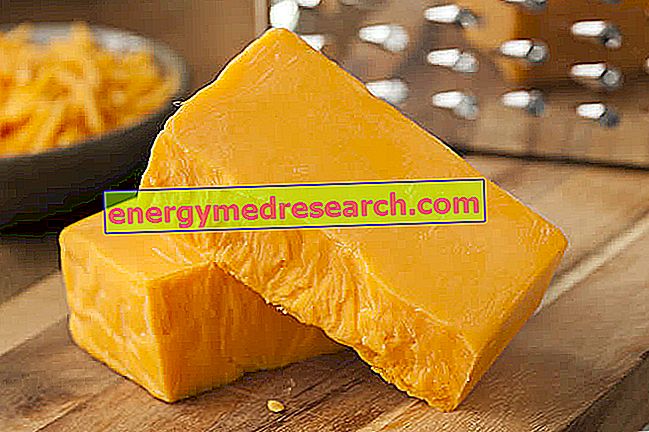What is Cheddar
Cheddar is a food that is one of the dairy products.
It is a typical Anglo-Saxon cheese, with a relatively compact consistency, with an intense flavor, sometimes acidulous, and an off-white or orange color (if color additives such as annatto or E160b are added).

Cheddar originates from the English village of Cheddar, in Somerset; however, many similar cheeses are also produced elsewhere and can be found almost all over the world (USA, New Zealand, Australia, etc.).
Cheddar is the most popular cheese in the United Kingdom; here, it represents 51% of the national market, for a total value of 1.9 billion pounds a year. After mozzarella, cheddar is also the second most popular cheese in the United States, with an average annual consumption of 4.5kg per capita.
In 2010, the United States produced 1, 466, 640 tons of cheddar; in 2008, the United Kingdom delivered 258, 000 tons.
The indication "Cheddar Cheese" is used for various products that are apparently very similar, although, within the European Union, the name "Cheddar Cheese" does not yet enjoy the "Protected Designation of Origin" (PDO). In fact, only the "West Country Farmhouse Cheddar", or the cheddar obtained from milk in the four counties of South West England, enjoys this precious recognition.
Nutritional Features
Cheddar cheese is a rather caloric food, with an energy prevalence attributable to lipids, followed by proteins and very small amounts of carbohydrates.
The fatty acids prevalent in cheddar should be saturated (detail not shown in the table). Peptides have a high biological value and simple carbohydrates (lactose).
The fibers are absent, while the cholesterol content - absent in the table - is certainly more than significant.
| Nutritional Composition per 100g of Cheddar | |||||||||||||||||||||||||||||||||||||||||||||||||||||||||||||||||||||||||||||||||||||||||||||||
 | |||||||||||||||||||||||||||||||||||||||||||||||||||||||||||||||||||||||||||||||||||||||||||||||
Nutritional values (per 100 g of edible portion)
| |||||||||||||||||||||||||||||||||||||||||||||||||||||||||||||||||||||||||||||||||||||||||||||||
From a saline point of view, cheddar provides high amounts of sodium, phosphorus and calcium; as far as vitamins are concerned, the concentrations of retinol equivalent (vit A) and riboflavin (vit B2) stand out.
Cheddar is a food that does not lend itself to feeding the overweight subject, as it is very fat and with an energy density such as to require almost insignificant portions.
To be avoided also in the case of hypercholesterolemia, since it should contain mainly saturated fatty acids and a fraction of cholesterol that is more than relevant.
Cheddar is not even relevant in the case of high blood pressure, as the high sodium content (caused by the added salt in production) could increase the risk of aggravation.
This cheese does not seem to contain a very high amount of lactose, but the most sensitive intolerant subjects could still have adverse gastrointestinal reactions.
Perfectly tolerated in the case of celiac disease, the cheddar produced with alternative ingredients to rennet respects the alimentary criterion of the vegetarian lacto ovo; it is however excluded from the diet of vegans, raw foodists and Jews.
Outline of Production
Cheddar, or rather "West Country Farmhouse Cheddar", is a semi-cooked and pressed hard cheese made from whole, raw or more pasteurized cow's milk.
For the production of cheddar, it is first of all necessary to separate the curd from the whey. This is done using rennet, an enzyme complex produced by the stomach of newborn calves. To obtain a cheddar suitable for vegetarian and kosher food, bacteria, yeasts and / or chymosin are used (or rennina, a synthetic hydrolase enzyme).
Then comes the so-called "cheddaring" phase, which is the peculiar aspect of cheddar production. In this process, after heating the curd, it is mixed with salt and cut into cubes; the latter are then stacked and systematically turned to better drain the serum.
The dry cheddar curd is then ground and placed in molds of varying sizes (from 5 to 60kg). The finished cheddar is wrapped in canvas or coated with wax, covered with a thin crust.
The "Strong" and "the Extra-Mature", sometimes called "Vintage", need to be matured for a maximum period of 15 months; in this way, it gets more intense scents, such as hazelnut, toasting and spicy. The cheese is stored and aged at a constant temperature and often requires special plants. In fact, as with many other hard cheese varieties produced throughout the world, cheddar also improves its characteristics in caves; these offer an ideal maturing environment and are ideal for the "West Country Farmhouse Cheddar". Even today, a small amount of cheddar is matured inside the caves of "Wookey Hole" and "Cheddar Gorge". Also, some versions of cheddar cheese are smoked.



